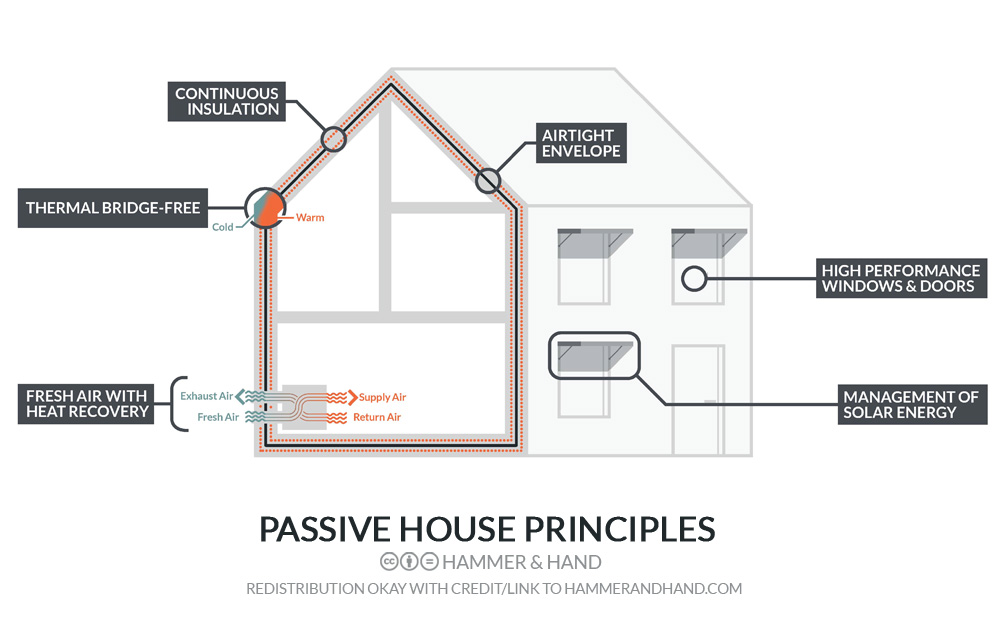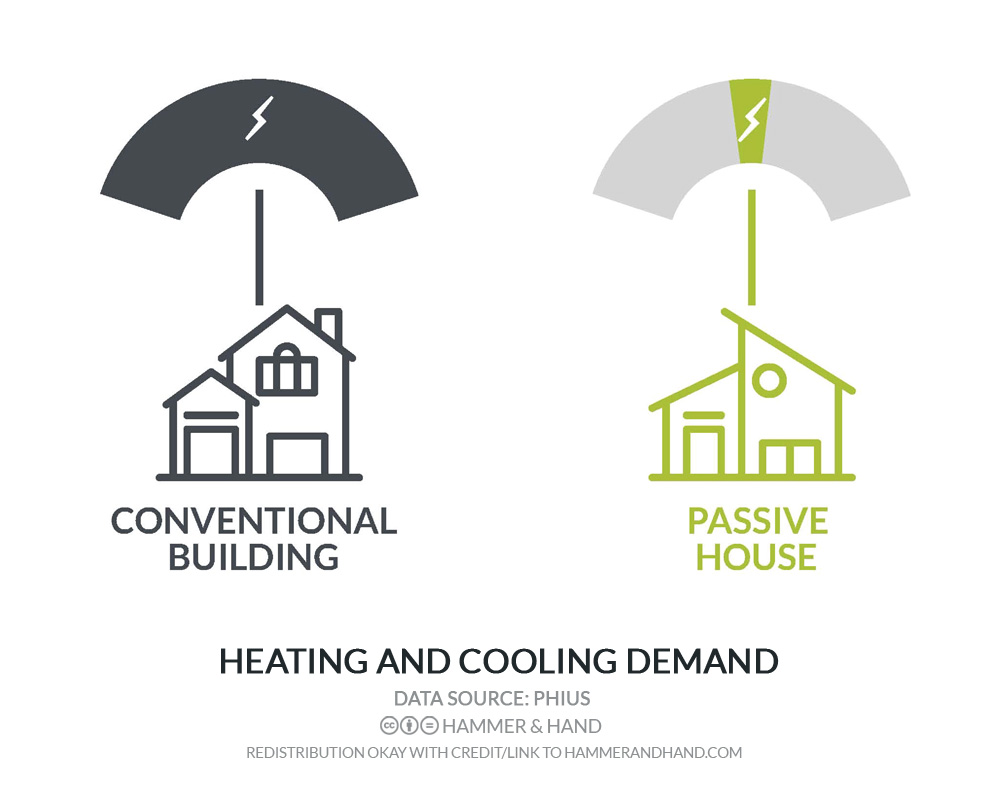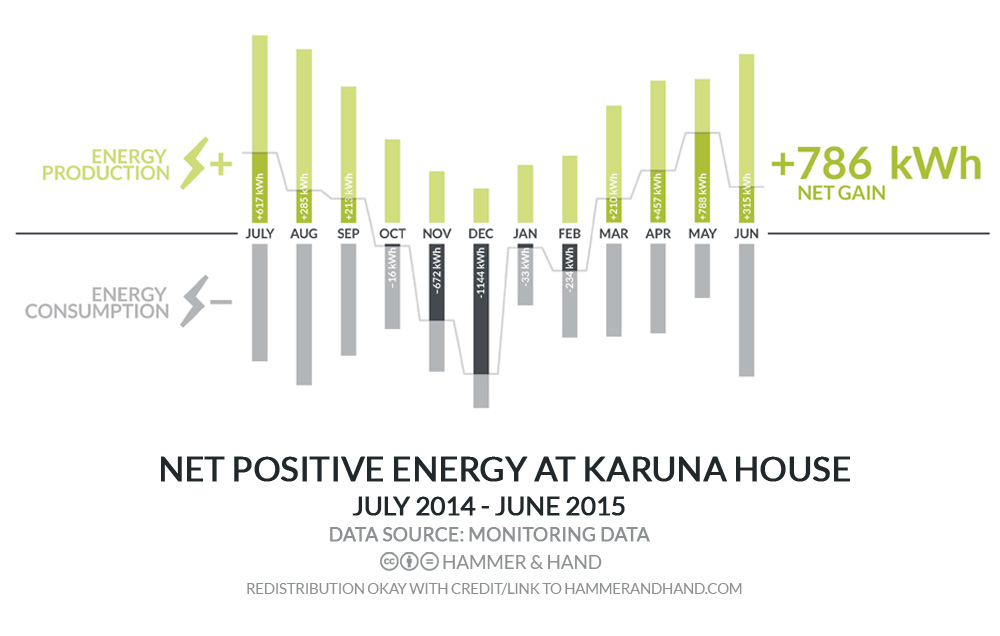HIGH PERFORMANCE BUILDING 101
What is High Performance Building?
It’s time to change the way we as an industry build. We now have the science to make buildings that are healthier, more comfortable, more durable, and easier on the planet. Today we can accurately model and understand how heat, air, and moisture interact with buildings and building components, and this knowledge – building science – empowers us to revolutionize the performance of buildings in practical, cost-effective, and safe ways.
In response, a suite of green building certifications that focus on high performance building have emerged:
Passive House (aka Passivhaus) is the standard bearer of high performance building, achieving revolutionary improvements in building in energy performance. The performance-based certification is straightforward: does the building meet the bar on airtightness, heating and cooling energy demand, and overall energy demand? At Hammer & Hand we typically certify our Passive House projects with the US-based Passive House Institute US (PHIUS), though the German Passivhaus Institut is another good option. (See Pumpkin Ridge Passive House as one of many Passive House examples built by H&H.)
Net zero energy buildings (projects whose annual onsite energy generation equals or exceeds annual building energy consumption) also depend on excellent energy performance, making Passive House design and construction a natural complement to net zero energy building projects. The International Living Future Institute (ILFI) offers a robust Net Zero Energy Building certification that requires verification based on one year of measured energy data. (Madrona Passive House is registered with ILFI’s Net Zero Energy Building program, with certification expected in late 2016.) Earth Advantage and Built Green both administer local net zero building certifications as well.
ILFI’s Living Building Challenge is the moonshot of high performance and green building and includes net zero energy performance as one of seven all-encompassing green building targets or “petals.” The Bullitt Center, home to H&H’s Seattle office, is perhaps the most famous example of a certified Living Building.
LEED has been less successful at ensuring excellent energy performance than these other certifications, but its broad sustainability goals make it a good complement to the energy focus of both Passive House and net zero energy building. (Karuna House combined LEED and Passive House certifications.)
In our view, the key to high performance building is to focus first on the building envelope – walls, roof and foundation. This High Performance Building 101 section of our website dives into the details of this conservation-first approach and its many benefits.
 Airtight construction controls the transfer of heat and moisture into and through the building envelope. Thermal bridge-free assemblies avoid the envelope penetrations that sap buildings of energy, comfort, and durability. Continuous insulation keeps heat where it’s wanted. Excellent windows and doors limit heat loss while capturing daylight and passive solar energy. Shading elements shield the building from passive solar gains when unwanted. And a constant supply of filtered fresh air comes in through a balanced heat recovery (or energy recovery) ventilation system that recaptures the thermal energy of exhaust air and keeps it inside the building.
Airtight construction controls the transfer of heat and moisture into and through the building envelope. Thermal bridge-free assemblies avoid the envelope penetrations that sap buildings of energy, comfort, and durability. Continuous insulation keeps heat where it’s wanted. Excellent windows and doors limit heat loss while capturing daylight and passive solar energy. Shading elements shield the building from passive solar gains when unwanted. And a constant supply of filtered fresh air comes in through a balanced heat recovery (or energy recovery) ventilation system that recaptures the thermal energy of exhaust air and keeps it inside the building.
By investing in an advanced building envelope we can dramatically reduce the energy demand to heat and cool high performance building. In fact, Passive House buildings routinely reduce heating energy by 90%.

Small heat pumps can then meet this small heating and cooling demand super-efficiently. Even after adding in lighting and plug loads, building energy use is so low that a relatively modest solar array can bring high performance passive buildings to net zero energy performance.
 From a builder’s perspective, the beauty of high performance building is that it’s not just about making our carbon footprint smaller, it’s just the right way to build. The same suite of strategies and components that delivers über-efficiency also makes for buildings that are more durable, comfortable, and healthy. The diagrams below show US Department of Energy’s assessment of how Passive House buildings perform compared to ENERGY STAR and conventional buildings, based on four key features: comfort, health, durability, and efficiency. The high performance Passive House buildings significantly outperform the others on all four measures.
From a builder’s perspective, the beauty of high performance building is that it’s not just about making our carbon footprint smaller, it’s just the right way to build. The same suite of strategies and components that delivers über-efficiency also makes for buildings that are more durable, comfortable, and healthy. The diagrams below show US Department of Energy’s assessment of how Passive House buildings perform compared to ENERGY STAR and conventional buildings, based on four key features: comfort, health, durability, and efficiency. The high performance Passive House buildings significantly outperform the others on all four measures.
 High performance building requires a holistic approach, with high performance building strategies and components integrated with one another in a web.
High performance building requires a holistic approach, with high performance building strategies and components integrated with one another in a web.  This web reflects the fact that buildings behave as systems, much like ecosystems. Changes to one part of the system can have big impacts elsewhere. There’s a critical difference between ecology and building science, however. Ecosystems are wildly complex. Buildings? Not so wildly, so they are knowable and manipulable given the right building science knowledge. High performance buildings, and the multi-layered benefits they bring, are the manifestation of our systems-based understanding of building physics.
This web reflects the fact that buildings behave as systems, much like ecosystems. Changes to one part of the system can have big impacts elsewhere. There’s a critical difference between ecology and building science, however. Ecosystems are wildly complex. Buildings? Not so wildly, so they are knowable and manipulable given the right building science knowledge. High performance buildings, and the multi-layered benefits they bring, are the manifestation of our systems-based understanding of building physics.